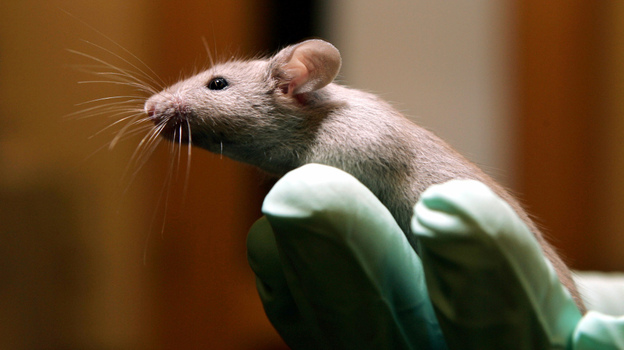Perhaps Scientists Like Lab Mice TOO Much
 Enlarge Robert F. Bukaty/AP
Enlarge Robert F. Bukaty/AP A technician holds a laboratory mouse at the Jackson Laboratory in Bar Harbor, Maine. The lab ships more than two million mice a year to qualified researchers.
Robert F. Bukaty/APA technician holds a laboratory mouse at the Jackson Laboratory in Bar Harbor, Maine. The lab ships more than two million mice a year to qualified researchers.
The lab mouse is the most ubiquitous animal in biomedical research, but that doesn't mean it's always the best subject for researching disease.
In a series of articles for Slate magazine, Daniel Engber looked into why the mouse is such a mainstay of science ? and whether that's a good thing.
"All of this is about standardization," Engber tells weekends on All Things Considered guest host Laura Sullivan. "It's easier for scientists ? and it's cheaper ? if everyone's using the same animal."
A 2008 study by the European Union found that mice accounted for about 59 percent of animals used for lab experiments. In fact, the number of mice studies has quadrupled since 1965, according to the National Library of Medicine databases. In contrast, studies on dogs and cats, rabbits, guinea pigs, zebra fish, fruit flies and other animals have remained about the same.
There's a monoculture in biomedical research that revolves around mice testing, Engber explains. Mice are easy to get and easy to maintain. It's easier to acquire grant money for studies on mice than for other, more complicated animals. But that doesn't mean they're the right animal for the job.
Take tuberculosis, for example. Mice have been used almost exclusively in tuberculosis research for the last 30 or 40 years, Engber says, but because the human respiratory system is structured differently, mice and humans actually get different types of tuberculosis.
"Any animal model you use for disease is going to be similar to the human version of disease in some ways and different in other ways," he says. "If all of your experiments are done on the same animal, those differences are just going to keep coming up again and again and again. It's self-limiting."
Not only that, lab mice are sedentary and overweight compared to their wild counterparts. Engber says that can skew the baseline of any study requiring a healthy mouse for a constant.
So why not switch to another animal?
Mice remain the number one subjects because so many tools used in research and genetic engineering are built around the mouse, Engber says. For many scientists, switching would be expensive and abrupt ? almost like switching a language.
"In science, in bio-medicine, people talk about being, you know, 'I'm a mouse person. I'm a monkey person'," Engber says. "At conferences, the mouse people will sort of cluster around posters of mouse studies and monkey people will cluster around posters of monkey studies."
But with the modern lab mouse almost exhaustively studied, he suggests, diversification could lead to new scientific discoveries.
"Let's invest more money into at least developing the science of the naked mole rat, the marmoset, the python ? whatever. Some other animals that might have some other secrets to share about the nature of disease."
Source: http://www.npr.org/2011/11/19/142517645/perhaps-scientists-like-lab-mice-too-much?ft=1&f=1007
dallas cowboys ct news hemlock hemlock mark rothko mark rothko wiccan

0 Comments:
Post a Comment
Subscribe to Post Comments [Atom]
<< Home